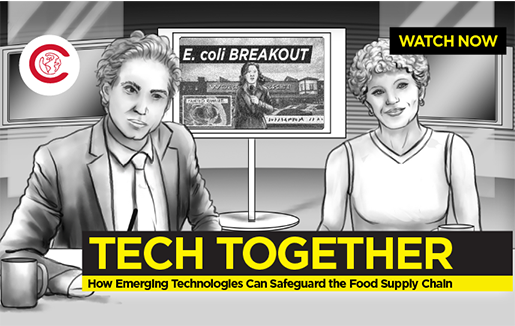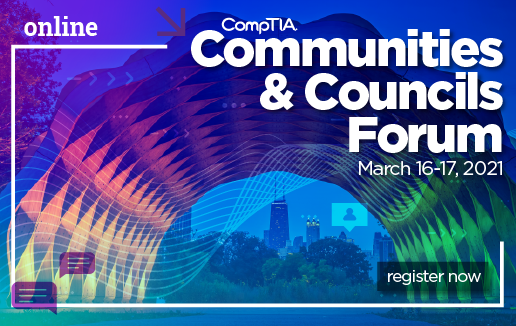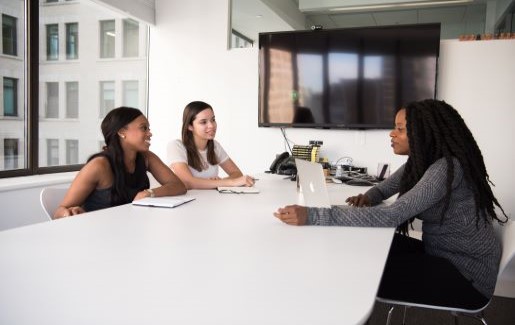
An E. coli outbreak of romaine lettuce made national news in late 2019, an incident that lasted more than two months and infected 167 people in 27 states, sending 85 to the hospital. The year before, a similar outbreak caused the Centers for Disease Control and Prevention to tell Americans to throw away all romaine lettuce. How could it have been prevented? Members of CompTIA’s Industry Advisory Councils think they have an answer.
The council members believe their respective technologies could be implemented in an end-to-end solution that would raise red flags at multiple points along the supply chain and prevent the lettuce from ever reaching customers’ hands. To demonstrate, four of the councils (Artificial Intelligence, Blockchain, Drones and IoT) collaborated to create a video that explains how the emerging technologies could minimize a potential E. coli risk.
The video, available here, begins with a TV newscast talking about an outbreak, before “rewinding” to a farm scene where drones and IoT sensors capture data about the produce, which is picked, placed on a truck, and shipped to a warehouse. Behind the scenes, AI analyzes the data, which is written to a blockchain, an immutable record of the data. All told, the four technologies recognize a potential problem, the produce is tested and ultimately destroyed because it’s infected. At the end, the TV news team broadcasts a much happier story because the outbreak never happened.
Council Collaboration Shines a Light on Real-Life Business Problem
The idea of a video illustrating how seemingly disparate emerging technologies can work together for such a potentially important solution was borne out of a year-end planning meeting for CompTIA’s communities and Industry Advisory Councils. Historically, the councils huddle on their own respective projects, but several members at the end of 2019 talked about collaborating on a bigger project together.
“There were some obvious opportunities to bring all the technologies together,” said Adam Lesh, technologist at AL Consulting and chair of the Blockchain Advisory Council. “For example, blockchain is a supportive technology. It’s not a front-facing technology. Everything we do is in support of something else. It occurred to me as we were attending the 2019 wrap-up sessions that blockchain is a data collector, we log and store data. AI needs a ton of data and drones and IoT generate a lot of data. It seemed like a natural fit. Once I got a few of the other councils on board, the next step was to focus on solving a business problem. We just needed to figure out how to tell the story.”
The other councils were amenable to working together and met virtually on a regular basis throughout 2020 to produce the storyboards, script and ultimately the video.
“This project was a case of ‘1+1=3.’ None of the technologies could have stood up by themselves to create a solution as meaningful and as important as what we did here,” said Robert Senatore, CEO of Data2Go Wireless and a past co-chair of CompTIA’s IoT Advisory Council. “In order to create a seamless solution tied to keeping the public healthy and safe, it took input from multiple technologies. “We all hope that this project sends a message of unity between new technologies and that working together creates more effective solutions for the public.”
Exemplifying How Emerging Technologies Can Make Life Better
The councils’ goal is to get any tech companies involved in the business of technology, from vendors to distributors to solution providers and MSPs, to recognize the value that each emerging tech brings to the table, both separately and together, and accelerate the development of more solutions that leverage the technologies.
“I hope people understand the interconnectedness and the power of these technologies working together,” said Tom Derhake, partner and co-founder of Cuesta Partners, a technology advisory firm, and member of CompTIA’s Artificial Intelligence Advisory Council. “The technologies are becoming common in language today, but it’s harder to grasp how they work together. To connect the dots with a live use case and see the underpinning technology driving it is super powerful.”
Working together, the council members found an unexpected benefit—they learned a lot about the other councils’ respective technologies, opening potential new doors within their own businesses. “It was exciting and also taught me more about blockchain and AI, which benefitted my ability to look at solutions at a higher level than the IoT world I live in every day,” Senatore said.
The success of the first project has also spurred progress on a second “Tech Together” project, which should be published later this year.
“It’s really valuable to look across different disciplines and explain an end-to-end use case to demystify the power of these technologies,” Derhake said. “I think it’s arguably most import reason I was interested. The interoperability of these technologies really unlocks value.”
Added Lesh, “Technology can be threatening, especially when people see it as eliminating jobs. We wanted to show some of the benevolent uses of emerging technologies that make life better and safer.”

 Add CompTIA to your favorite RSS reader
Add CompTIA to your favorite RSS reader

